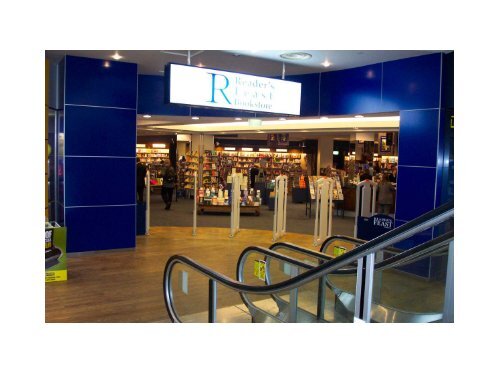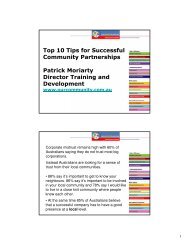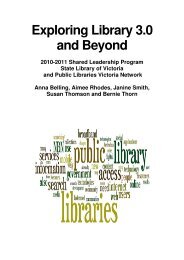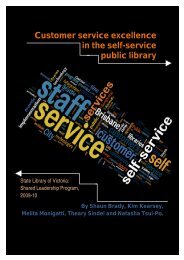Bookstore Presentation method & motivation
Bookstore Presentation method & motivation
Bookstore Presentation method & motivation
Create successful ePaper yourself
Turn your PDF publications into a flip-book with our unique Google optimized e-Paper software.
<strong>Bookstore</strong> <strong>Presentation</strong><br />
<strong>method</strong> & <strong>motivation</strong><br />
An overview of the practices of bookstore presentation<br />
and the factors that influence how a bookstore is organised.<br />
Some Pertinent Statistics of the environment in which I work<br />
•214,000 titles on the database<br />
•22 staff with average tenure of 9 years<br />
•average of 740,000 visitors per annum<br />
•average of 500 new releases each month<br />
•approximately 120 suppliers
<strong>Presentation</strong> Format<br />
I will cover the factors that lead to the way our bookstore is<br />
presented and give some practical examples of both the unique<br />
and standard characteristics of merchandising and<br />
presentation.<br />
•Store Culture<br />
•Store Patrons<br />
•Store Buying<br />
•Store Merchandising
Store Culture<br />
We have as our guiding philosophy that a<br />
bookstore should be a place peopled by<br />
enthusiastic and knowledgeable personnel, with<br />
an ambience that is comfortable and pleasant,<br />
and a range that is comprehensive and easily<br />
accessed.
Enthusiastic and knowledgeable personnel<br />
Deliberately recruiting to achieve an eclectic mix, I am most<br />
interested in having people with us who have a passion for<br />
books and who see their work environment as a statement of<br />
who they are, and as an integral part of their life.<br />
By so doing, I am forming the culture of the store that will<br />
attract and reflect the clientele.
Comfortable and pleasant ambience<br />
To reflect the management philosophy of the business, to cater for the<br />
highest productivity levels possible, and for practical reasons pertaining to<br />
Occupational Health & Safety, our store is:<br />
•Uncluttered and open at the front of the store to allow a visitor to sense that<br />
the world of books is opening before them<br />
•Spacious within - wide aisles, several open spaces with chairs scattered<br />
throughout the store, small tables on which to rest books<br />
•Unadorned - very few posters, clear signage throughout, no publisher<br />
advertising material<br />
•Personalised - ‘staff recommendations’ are prominent, ‘top shelf’ reflects<br />
the ‘gems’ in our range, flat tables are used to highlight buyers’ choices.
Comprehensive and easily accessed range<br />
We are one of the very few bookstores, if not the only one of<br />
our size, left in Australia, America, or Britain, where the<br />
buyers are also booksellers - that is, they work in the business<br />
every day and buy from the shop floor. This is vital because it<br />
illustrates how we build our range, and it is the range that is the<br />
other pillar of our business success, along with personnel and<br />
ambience.
Comprehensive and easily accessed range<br />
Three buyers see representatives from all the major and midrange<br />
suppliers each month with their list of new releases<br />
As well, they peruse catalogues from local and international<br />
publishers<br />
The internet is used to search for specific titles or areas of<br />
interest raised by our customers<br />
Media interest in subjects is monitored and of course book<br />
reviews are scanned and filed for all staff to access
Comprehensive and easily accessed range<br />
Our database is specific to the book trade and is particularly robust in the<br />
areas of accuracy and reporting. ISBN is the key field on which the<br />
information is built. At time of purchasing, the buyers designate the<br />
category and department into which a book title will be entered. It is then<br />
accessed either by ISBN, title, or author. This basic information is stored<br />
in a public access version of the database that is available for use from<br />
three terminals in the store. Our personnel can search also by purchasing<br />
history, receiving history, special order status, imprint, and<br />
publisher/supplier. Store design and signage is inextricably linked to the<br />
order of categories and departments on the system.<br />
We also run online database searching systems at two points in the store<br />
for staff to access all books currently in print in Britain, USA, Australia,<br />
South Africa, and New Zealand.
STORE PATRONS<br />
Anyone and everyone who reads should be considered our<br />
clientele. We should, as a quality general bookseller, be able to<br />
cater for all needs whether directly through our range or by our<br />
special order service.<br />
Our demographic includes:<br />
•city workers<br />
•city residents<br />
•interstate and overseas visitors<br />
•Melburnians and Victorians
<strong>Bookstore</strong> Patrons<br />
Book lovers typically also love bookstores and feel connected to ‘their’ store.<br />
As a result, their expectation of our service and knowledge is extremely high.<br />
We know, through our experience and through the responses to a survey we<br />
ran some time back with our Privileged Reader Programme members, our<br />
patrons:<br />
•Absolutely value the fact that our booksellers remain with us and are<br />
therefore familiar to them<br />
•Want us to keep to a minimum the introduction of other merchandise rather<br />
than sacrifice book space<br />
•Value new book information ahead of discount or special offers<br />
•Want us to maintain the spaciousness of the store and the sense that whilst<br />
they can be given help if required, they are also welcome to stay in the store<br />
and browse.
STORE BUYING<br />
Establishing the tenets of our business and translating these into<br />
reality should mean that the experience of being in our store is<br />
comfortable and inviting. Indeed, as mentioned earlier, our<br />
store should reflect our clientele and vice versa.<br />
The choices in our purchasing and the ways in which we<br />
merchandise our store are the key elements that exemplify the<br />
store culture and the clientele interests.
Store Purchasing Decisions<br />
Utilising both the computer information at our disposal and our own buying<br />
prowess, we choose stock based on a number of variables:<br />
•Previous history: how the author/subject has sold<br />
•Trends in clients’ interests - e.g. we note that our Australian biographies are<br />
selling well and see the need to add to the range<br />
•We take note of the publicity campaigns organised and the media<br />
engagements confirmed for the author<br />
•We recognise gaps in our range and look for stock that will add to a subject<br />
area.<br />
•We expand our areas of interest to reflect an outlook that is interesting,<br />
unusual, ground-breaking.
Examples of buying decisions based on<br />
adding interest and uniqueness to our range<br />
IN TRANSLATION<br />
We set aside a small area in the store devoted to fiction titles that, in English,<br />
have been translated from the original source. This range invariably sells<br />
through every week - that is, we have to top up the section every week.<br />
Why?<br />
•It highlights titles that would possibly be lost on the shelves<br />
•It sends a message that we are interested in more than the bestsellers<br />
•It reflects a broad range and a depth of range not usually displayed in most<br />
stores
Examples of buying decisions based on<br />
adding interest and uniqueness to our range<br />
LIMITED EDITION OF 15 USHER’S ISLAND<br />
A collaboration between ourselves and the owner and restorer of James Joyce<br />
House, 15 Usher’s Island, Dublin, Ireland. We are the exclusive, worldwide<br />
stockist of this CD recording, packaged with a recording of “Dubliners”.<br />
Why is a Melbourne bookstore initiating and undertaking this?<br />
•Linked to to a dedicated website for Usher’s Island editions,this gives us a<br />
global clientele and the associated awareness of our business<br />
•It reinforces for our clientele and local publishers that we are innovative and<br />
enthusiastic which in turn will lead to other projects.<br />
•It provides us with a unique item that we can market and as such gives us a<br />
clear point of difference both in the item itself and the perception of how we<br />
conduct business
STORE MERCHANDISING<br />
Typical retail practice will include ideas and actions such as:<br />
•Add on<br />
•Sell up<br />
•No spare space on a display stand<br />
•Promotional bins and posters to push the latest release<br />
You will find none of these concepts per se in practice at<br />
Reader’s Feast
Merchandising to suit the client<br />
If, as I have demonstrated, my clientele is interested in<br />
information, is open to new and interesting ranges, and wants to<br />
feel comfortable and spend time in our store, then<br />
Our merchandising has to suit this set of criteria and above all<br />
be<br />
SUBTLE
Subtle but effective merchandising<br />
Our displays will be accessible and will reflect our range through the new<br />
releases from all categories, not just the obvious or expected bestsellers<br />
Our displays will reflect the buying decisions we have made and the titles<br />
we have felt worthy of inclusion in our book guide<br />
Our store will be uncrowded and will feature our recommendations rather<br />
than publisher promotional material that is obviously linked to purchasing<br />
deals<br />
We will include things such as the best sellers lists from the UK, Aust, and<br />
the USA to let the customer feel part of the global community of readers<br />
We will want to reflect our own reading tastes in our displays, featuring titles<br />
that have captivated us and which we want to promote to others as worthy of<br />
consideration
Good old fashioned retail merchandising<br />
Subtlety and a personal approach to merchandising doesn’t mean dispensing<br />
with correct procedures:<br />
•Always think about the view from each side of a display and try to ensure<br />
that book spines are on show<br />
•Never let a display run down but rather keep them topped up or change them<br />
if the item is moving fast<br />
•Change displays regularly, remembering that many of the clients are<br />
frequent visitors to the store<br />
•Theme displays so that the mix of titles makes sense<br />
•Think symmetrically - never let an end display be lopsided or looking slight
Reader’s Feast <strong>Bookstore</strong><br />
Hopefully I have given you a sense of the way everything<br />
in a bookstore is connected be it<br />
•The business ethos and culture<br />
•The anticipated clientele<br />
•The buying decisions<br />
•The merchandising<br />
I often talk with my colleagues about being ambassadors for<br />
our bookstore.<br />
This is how we should think about every aspect of our business.<br />
If we do, our whole store will tell our story.<br />
Mary Dalmau, June 2005.






